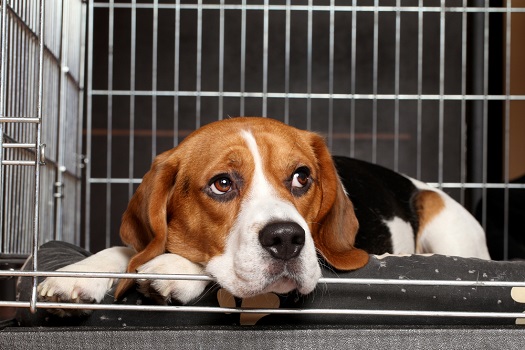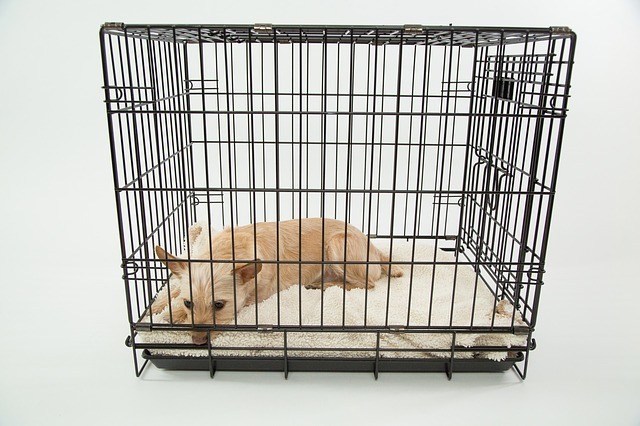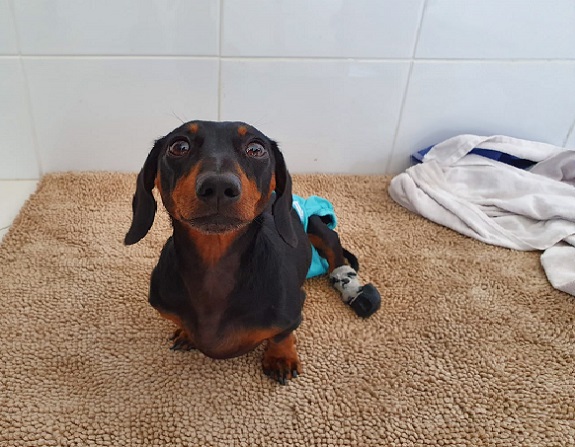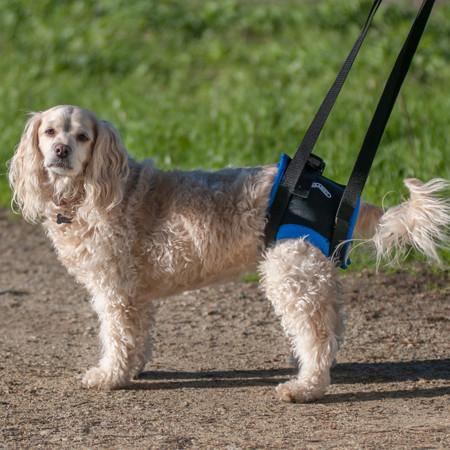
Table of Contents[Hide][Show]
No pet owner likes to hear that crate rest has been prescribed for their IVDD dog. The idea conjures up images of you as the jailer and your pup as the prisoner. It’s not a job any animal lover wants.
But if your dog suffers from Intervertebral Disc Disease chances are good that periodic bedrest will be part of their life. It’s the nature of the condition. IVDD can cause painful episodes as the discs in the spine deteriorate and many patients need spine surgery. Each calls for strict crate rest to help the dog heal. It’s the best option for a full recovery.
Note: If your dog shows signs of a spine problem or is suddenly paralyzed go to the vet immediately. Do not use crate rest in lieu of medical care. Signs include: whimpering, wobbly walk, trembling, arched back, change in the way the head is held and a reluctance to move.
This post contains affiliate links.

Ask & Discover
Get personalized content recommendations and answers drawn from our website. Simply type your question or topic of interest, and our AI assistant will help you find relevant articles, tips, and insights. You can also have a natural conversation to explore topics in more depth.
Setting your dog up for success
While strict bedrest sounds like a daunting task, you have the power to make it a good experience vs. one that’s stressful. Your dog will take the lead from you.
The goal is to be confident and prepared. It’s up to you to make their temporary crated home safe and pleasant.
The first step to accomplish this goal is to get clear instructions from your vet about the restrictions your pup needs. Write them down so everyone in the house knows what’s expected and adhere to the plan exactly as prescribed. It will set the stage for success.
The definition of medical crate rest
Strict medical crate rest means the complete confinement of your dog, in a crate or X-pen, 24 hours a day for a determined length of time.
Dogs are allowed out of their cage for bathroom breaks and veterinary appointments, only.
How long is crate rest prescribed for IVDD dogs?

The experts at Dodgerslist, say that 6-8 weeks of confinement is required for dogs who are being treated conservatively. That means they didn’t have surgery and are undergoing a treatment regime of bedrest, pain medication and steroids to reduce inflammation.
The goal is to give their body time to build enough scar tissue around the injured area to stabilize the spine.
Veterinary Partner recommends a minimum of 3-4 weeks of strict crate rest for dogs who’ve had spine surgery. This is followed by a more relaxed form of confinement where dogs can walk a bit on their own and start physical therapy.
But whatever time period has been chosen for your pet, be prepared to face a huge pitfall at the halfway point. It happens to every caretaker, especially if your dog is feeling better. You’ll be tempted to stop crate rest early.
So make a mental note, ending crate rest sooner than prescribed is the number #1 cause of reinjury.
How to pick the right crate

Crates come in lots of styles so picking one can seem confusing at first. If you’re having trouble making a selection here’s an important rule to remember.
Choose a crate that’s big enough for your pet to stand up, turn around in a small circle, and stretch out when lying down.
Dog crate styles:
- Wire crates – This is the most popular cage for confinement. Wire crates are sturdy, have a door for easy access to your dog and have a solid floor for comfort. They’re easy to clean, provide good protection and fold up when you don’t need them anymore.
- X-pens – This is the second most popular style. X-pens are great for large dogs because they provide extra space. You can also adjust the shape of the pen to fit a room. One drawback is their lack of a floor or top. You’ll definitely need to add a bed or blanket. Owners should look for an X-pen with a door for easy access and make sure the height is tall enough so your dog can’t get out. X-pens fold nicely for storage.
- Wood crates – This type of crate is built to look like a piece of furniture. They call attention to themselves like a big X-pen. They’re a good choice if you think you’ll be using a crate for long time. Wood crates are cozy and provide excellent protection. They’re also more expensive than other styles.
- Soft-sided crates – These are relatively new to the market. They’re a good choice if your dog is small and space is limited or if you plan to transport your dog. The cage is made of soft durable materials with a solid top and floor. The walls have mesh siding to let air in and out. Some soft-sided crates fold up for storage.

Get the Essential Guide
The Essential Guide of Products for Handicapped Dogs e-book is a labor of love for me. I wrote it to answer your most pressing questions about where to find the best products for your wheelchair dog. You’ll find products you didn’t know existed and each will improve your dog’s quality of life. Print a copy and keep it by your side.
How to create the perfect crate experience
Once you’ve picked the right crate, it’s time to decide where to place it and what to put inside. This sounds like a simple task, but your decisions play an important role for your dog’s well-being. Here are guidelines to consider:
- Place the crate in a part of a room where your dog can see you. They’re still part of the family and want you close by.
- Put the cage where there’s good air flow.
- Be sure the temperature isn’t too hot or too cold.
- A blanket or crate mat can be added to the bottom of the cage if you think the temperature might dip at night.
- Add a non-slip mat to the floor of the crate.
- An orthopedic dog bed is good. Dogs love to curl up in them and they stop pressure sores from developing.
- Place puppy pads in the crate for the quick clean-ups.
- Make sure all of the bedding is approved by your vet.
- Set the crate in an area where it won’t get bumped. You don’t want to accidently trip over your dog. A corner works better than in the middle of a room.
- If possible, gradually introduce your pet to the confined area. It helps with anxiety.
- Post a sign outside the crate with instructions about your dog’s restrictions. Everyone should be aware of the isolation orders.
- Add a Be Quiet sign at the front door. A ringing doorbell can cause your dog to jump and bark.
- Remove any collars that might get caught in wires of the crate.
- Stay by your dog’s side until they feel comfortable. Petfinder reported, “A dog who panics when left alone in a crate could do damage to the crate and, more seriously, to himself.”
- Add toys that stimulate your dog’s brain. Healthy chews or food dispensing toys keeps dogs from getting bored.
Follow any special instructions

If your dog’s had spine surgery it’s likely the veterinarian will send you home with special instructions for the first several days.
Instructions can include:
- Removing any soft bedding from the crate
- Minimal contact with your pup
- No playtime
- Eliminating toys that encourage pulling or tugging
- Specific times for rest
- Carrying your pet for bathroom breaks instead of allowing them to walk
These initial instructions can be very limiting so talk with your vet regularly about activities you can add back as your dog improves. You should also have a discussion about rehab exercises your dog can begin.
Click here to read: 9 Dog Physical Therapy Exercises You Can Do At Home
Penny’s story

Penny was diagnosed with IVDD after falling down in pain in her backyard. Her tail and hind legs were paralyzed. Because veterinary services were limited in her part of the world, crate rest was prescribed for the little Dachshund. Her owner, Sally, used a small room to limit where Penny could go. Sally made the room cozy and comfortable.
Sally didn’t let the lack of treatment options stop her from helping her pup. She watched YouTube videos about canine physical therapy and when the vet gave the okay, Sally and Penny started their own rehab sessions. They began with short, 5 minute workouts that included “range of motion” exercises and gentle massage.
Slowly Penny began to respond to the treatment. Nine months later, the little dog was able to stand and walk on her own.

My favorite harnesses for disabled dogs.
Establish a good daily routine
A solid schedule is vital to your success. It should include activities your dog does from sunrise to sunset. Here’s an idea of what to include:
- If your dog’s allowed to go outdoors, schedule 3 – 5 bathroom breaks each day. They should be in the morning right after your dog wakes up, 15 minutes after each meal and before bed. Keep sessions to 5 minutes outside, until your vet clears longer periods. And if your dog can’t go outdoors schedule the same number of times to do diaper changes or express your dog’s bladder indoors.
- Serve breakfast and dinner inside the crate.
- Schedule daily rest periods. This is important for healing. Rest periods are in addition to the hours your dog sleeps at night. They’re stretches of time when an animal is left alone to settle down and relax without you being by their side.
- Schedule “fun time” where you interact with your dog. Quality time of gentle play will remind both of you about the bond you share.
Keep your dog engaged in life
A dog’s mind needs to stay active to prevent boredom and depression. It’s easy to accomplish this by spending a few minutes interacting. Set yourself down next to the crate at eye-level and talk to your pup.
Like people, our dogs feel better when they hear a soothing voice and know you’re watching out for them. They feel secure and peaceful.
The key to a surviving crate rest is to put yourself in your dog’s situation. Their life has changed from doing “zoomies” in the backyard, to being locked up in a confined space. They’re worried and probably in pain.
So, treat your dog like you would want to be treated after surgery or a trauma. I promise it will make the road to recovery, a smooth one.




Thank you setting up this website, it really helps us.
Our little dachshund Gretchen had her surgery 2 days ago and next will be cage rest for two months and then rehab and physical therapy
I want to mention that time is essentially after the injury, the 24 hour clinic were we took her did not tell us that the changes of recovery are best if surgery is performed within 24 hours after the injury.They did send us home with a very sick dog who was paralyzed in the back and unable to urinate and recommended cage rest.Do your own investigation and take immediate action
Hans, I’m sorry to hear about your dachshund. You’re right about it being important to have surgery as soon as possible after a spinal injury or incident. It’s hard to vets to remember to tell families everything they need to know. That’s why I started this blog. I hope Gretchen has a good recovery. Ask your vet about when you can introduce physical therapy as there are some gentle range of motion exercises and feet touching that can stimulate the nerves. Here’s a post to help you: https://dogwheelchairlife.com/9-dog-physical-therapy-exercises-you-can-do-at-home/
Thank you setting up this website, it really helps us.
Our little dachshund Gretchen had her surgery 2 days ago and next will be cage rest for two months and then rehab and physical therapy
I want to mention that time is essentially after the injury, the 24 hour clinic were we took her did not tell us that the changes of recovery are best if surgery is performed within 24 hours after the injury.They did send us home with a very sick dog who was paralyzed in the back and unable to urinate and recommended cage rest.Do your own investigation and take immediate action
Hans, I’m sorry to hear about your dachshund. You’re right about it being important to have surgery as soon as possible after a spinal injury or incident. It’s hard to vets to remember to tell families everything they need to know. That’s why I started this blog. I hope Gretchen has a good recovery. Ask your vet about when you can introduce physical therapy as there are some gentle range of motion exercises and feet touching that can stimulate the nerves. Here’s a post to help you: https://dogwheelchairlife.com/9-dog-physical-therapy-exercises-you-can-do-at-home/
Thank you so much for this blog! A lot of important information! My beagle mix just had spine surgery 3 weeks ago. My poor pup had to wait a whole day to get surgery because there was no MRI machine available and the neurosurgeon wasn’t in until the next day…. However Friday will be his follow up appointment! Hoping for a speedy recovery!
I hope your dog has a full recovery. Feel free to send us any questions you have.